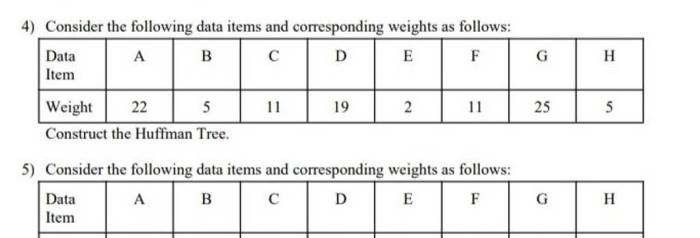In the realm of data interpretation, consider the following data and corresponding weights. emerges as a pivotal concept, guiding decision-makers toward informed and effective outcomes. This article delves into the significance of considering both data and their associated weights, exploring the impact they hold in shaping decision-making processes.
Data, the raw material of decision-making, provides valuable insights into the world around us. However, the mere presence of data is insufficient; its interpretation and utilization hinge upon the consideration of corresponding weights. These weights, assigned to each data point, reflect their relative importance and relevance to the decision at hand.
Data Interpretation: Consider The Following Data And Corresponding Weights.

Considering both data and corresponding weights is crucial for effective decision-making. Data alone provides raw information, while weights assign significance to different data points, allowing for more nuanced analysis and decision-making.
For instance, in a customer satisfaction survey, the number of positive responses alone may not be sufficient. By considering the weights of different customer segments, businesses can prioritize addressing the concerns of more influential or valuable customers.
Potential Biases or Limitations, Consider the following data and corresponding weights.
- Data Accuracy:Inaccurate data or incorrect weights can lead to biased or flawed decisions.
- Subjectivity:Weighting methods can be subjective, introducing bias based on the perspectives of the decision-makers.
- Overweighting or Underweighting:Assigning excessive or insufficient weights to certain data points can distort the analysis.
Weighting Methods

Various weighting methods exist, each with its advantages and disadvantages:
- Equal Weighting:All data points are given the same weight, assuming equal importance.
- Importance Weighting:Data points are weighted based on their perceived importance or relevance to the decision.
- Frequency Weighting:Data points are weighted based on their frequency of occurrence or repetition.
- Expert Weighting:Weights are assigned by subject matter experts based on their knowledge and experience.
| Method | Advantages | Disadvantages |
|---|---|---|
| Equal Weighting | Simple and unbiased | May not capture the importance of different data points |
| Importance Weighting | Allows for prioritization of important data | Can be subjective and introduce bias |
| Frequency Weighting | Objective and based on data patterns | May overemphasize frequently occurring data |
| Expert Weighting | Leverages expert knowledge | Can be limited by the expertise and perspectives of the experts |
Data Analysis

Analyzing data with corresponding weights involves the following steps:
- Data Preparation:Clean and prepare the data, ensuring accuracy and consistency.
- Weight Assignment:Determine and assign weights to data points using an appropriate weighting method.
- Weighted Analysis:Perform statistical analysis or modeling considering the weights, such as weighted averages or regression models.
- Interpretation:Draw conclusions and make decisions based on the results of the weighted analysis, taking into account the significance of the weights.
A flowchart illustrating the data analysis process:
[Flowchart: Data Preparation -> Weight Assignment -> Weighted Analysis -> Interpretation]
Case Studies

Consider the following case studies:
- Customer Segmentation:A retail company used weighted data to identify valuable customer segments based on purchase history and demographics, leading to targeted marketing campaigns that increased sales.
- Product Development:A technology company analyzed customer feedback with weighted importance to prioritize product features, resulting in a product that better met customer needs.
- Risk Assessment:A financial institution used expert-weighted data to evaluate investment risks, enabling more informed decision-making and reduced potential losses.
Questions Often Asked
What is the significance of considering both data and corresponding weights?
Considering both data and corresponding weights allows decision-makers to prioritize and interpret data effectively. Weights assign relative importance to data points, ensuring that the most relevant information is given due consideration.
How can data and weights influence decision-making?
Data and weights play a crucial role in decision-making by providing a structured and informed basis for evaluating options. By considering the relative importance of different data points, decision-makers can make more accurate and justifiable choices.
What are some potential biases or limitations that may arise when considering data with weights?
Potential biases or limitations include the subjective assignment of weights, the availability of relevant data, and the accuracy of the data itself. It is important to acknowledge and address these limitations to ensure the validity and reliability of the decision-making process.